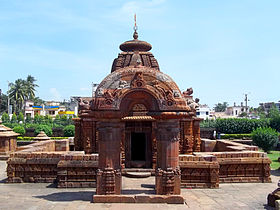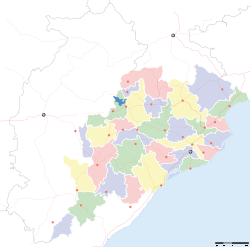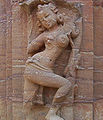- Muktesvara deula
-
Muktesvara deula
ମୁକ୍ତେଶ୍ଵର ଦେଉଳ
Coordinates: 20°14′29.7″N 85°51′6.49″E / 20.241583°N 85.8518028°ECoordinates: 20°14′29.7″N 85°51′6.49″E / 20.241583°N 85.8518028°E Location Country: India State/province: Orissa District: Khurda Architecture and culture Primary deity: Muktesvara (Shiva) Architectural styles: Kalinga architecture History Date built:
(Current structure)970 A.D. Muktesvara deula (Oriya: ମୁକ୍ତେଶ୍ଵର ଦେଉଳ) is a 10th century Hindu temple dedicated to Lord Siva located in Bhubaneshwar, Orissa, India. The temple dates back to 970 A.D., is a monument of singular importance in the study of the development of Hindu temples in Orissa. In this stylistic development the Mukteswara plays a pivotal role; it marks the culmination of all earlier developments, and initiates a period of experiment which continues for an entire century, as seen in such temples as the Rajarani Temple and Lingaraj temple, both located in Bhubaneswar.[1]
Contents
The Porch
The temples most striking feature is the torana, or the arched gateway, dating back to about 900 A.D. and showing the influence of Buddhist architecture. The Gateway to the Mukteswara Temple, modeled on the torana recovered from the field in Bhubaneswar, bears sculptures that range from elaborate scrolls to pleasant female forms and figures of monkeys and peacocks. The arched gateway has thick pillars that have strings of beads and other ornaments carved on statues of smiling women in languorous repose. The porch is a waller chanber with a low, massive roof, and internal pillars are wholly wanting. The combination of vertical and horizontal lines is skillfully arranged so as to give dignity of buildings of moderate height. This early astylar form of the temple is best illustrated in this temple.[2]
Architecture
This distinctive 10th century temple is one of the smallest and most compact, decorated with intricate carvings and is the finest testimonial for the architectural cognizance of Vishwakarma Moharana sculptors. The temple is regarded as a gem of Nagara architecture of Kalinga architecture.[3] Except for the rectangular plan of its jaganmohana, it is the earliest example of what may be termed proper Orissa temple type; a vimana with a curvelinear spire and a jaganmohana with a stepped pyramidal roof.[4] This temple also reveals some notable features both in architectural and in the attributes of the cult images. In the cult images, we find here a rat used as a mount of Ganesa, a peacock associated with Karthikeya, babies carried in arms of Saptamatrikas and Ketu among the planets.[5] There is a tank inside the compound that is still in use by devotees. Women toss coins into the tank, wishing to cure infertility. The local saint, Lakulisa is carved into the doorway.
The temple's red sandstone is covered with exquisite carvings of lean Sadhus or holy men as well as voluptuous women encrusted with jewels. In the yard stands the Kedareswar Temple with a striking 8 foot statue of Ram Bhakt Hanuman (the monkey God).It is said that, taking a dip in the holy well cures a person of infertility. Mukteshwar temple exudes delicate sculpture. It is a perfect blend of ancient and modern designing and this is what makes it simply outstanding. This architecture is one of the basic reasons why Mukteswar temple is also known as the Gem of Orissa architecture.
Gallery
See Also
- List of temples in Bhubaneswar
References
- ^ The Mukteśvara Temple in Bhubaneswar P.xix. Walter Smith.
- ^ A history of fine art in India and Ceylon: from the earliest times to the present day. P.25. Vincent Arthur Smith.
- ^ General Studies History 4 Upsc.P.B-158.Reddy
- ^ Designs from Orissan Temples. P.24. D.P. Ghosh, Nirmal Kumar Bose and Y.D. Sharma
- ^ Encyclopedia of the Śaivism .P.164.Swami P. Anand, Swami Parmeshwaranand
External links
Hindu temples in Orissa Ganesh Temples Surya Temples Vishnu Temples Alarnatha Mandira · Anantasaayi Vishnu Temple · Ananta Shayana · Anantashayana, Saranga · Ananta Vasudeva Temple · Baladevjew Temple · Chakra Narasimha Temple · Chhatia Batta · Dharakote Temple · Gundicha Temple · Jagannath Temple, Koraput · Jagannath Temple, Nayagarh · Jagannath Temple, Puri · Kshirachora Gopinatha Temple · Lakhmi Varaha Temple · Madhava Temple · · Narayana Gosain Temple,Singapur · Nilamadhav Temple · Odogaon Raghunath Temple · Patali Srikhetra · Ram Mandir, Janpath · Sakshigopal Temple · Marjara Nrusimha Temple · Yajna Nrisimha Temple · Yajna Varaha TempleShiva Temples Ajaikapada Bhairava Temple · Akhandalmani Temple · Annakoteshvara Temple · Bhuvaneshwar Temple, Boudh · Brahmeswara · Chandaneswar · Chateshwar Temple · Dhabaleswar · Gupteswar Cave · Godhaneswar temple · Indralath Temple · Kapilash Temple · Kedareswar Temple · Kosaleswara Temple · Ladoo Baba Temple · Lingaraj Temple · Lokanatha Temple · Mahendragiri, Orissa · Markandeshwar Temple · Mukteswar Temple · Murga Mahadeva Shrine · Panchalingeshwar · Parsurameswar Temple · Rajarani Temple · Rameshwar Deula · Simhanath Temple · Subarnameru Temple · The Leaning Temple of Huma · Yameshwar TempleShakti Temples Bhadrakali Temple, Aharapada · Bhagabati Temple, Banapur · Bhattarika Temple · Biraja Temple · Charchika Temple · Chausath Jogini Temple · Durga Temple, Baideshwar · Durga Temple, Motia · Ghanteshwari Temple · Kakatpur Mangala Temple · Kalijai · Kanaka Durga, Raulapalli · Katak Chandi Temple · Kichakeshwari Temple · Lankeswari Temple · Maa Tarini · Maa Taratarini Temple · Maa Ugra Tara · Maheshwari Temple · Mahishamardini Temple · Majhighariani Temple · Manikeshwari Temple · Marichi Thakurani · Mausimaa Temple · Metakani Temple · Narayani Temple · Ramachandi Temple · Ranipur-Jharial · Samaleswari Temple · Saptamatruka Temple · Sarala Temple · Siddha Bhairavi · Sureswari temple · Upper Bagh Devi Temple · Vaital Deula · Varahi Deula, ChaurasiOthers Brahma Temple, Bindusagar · Brahma Temple, Niali · Hanuman Vatika · Harihara Deula · Harishankar Temple · Joranda Gadhi · Sasisena TempleCategories:- Hindu temples in Bhubaneswar
- Shiva temples
- Archaeological monuments in Orissa
Wikimedia Foundation. 2010.









